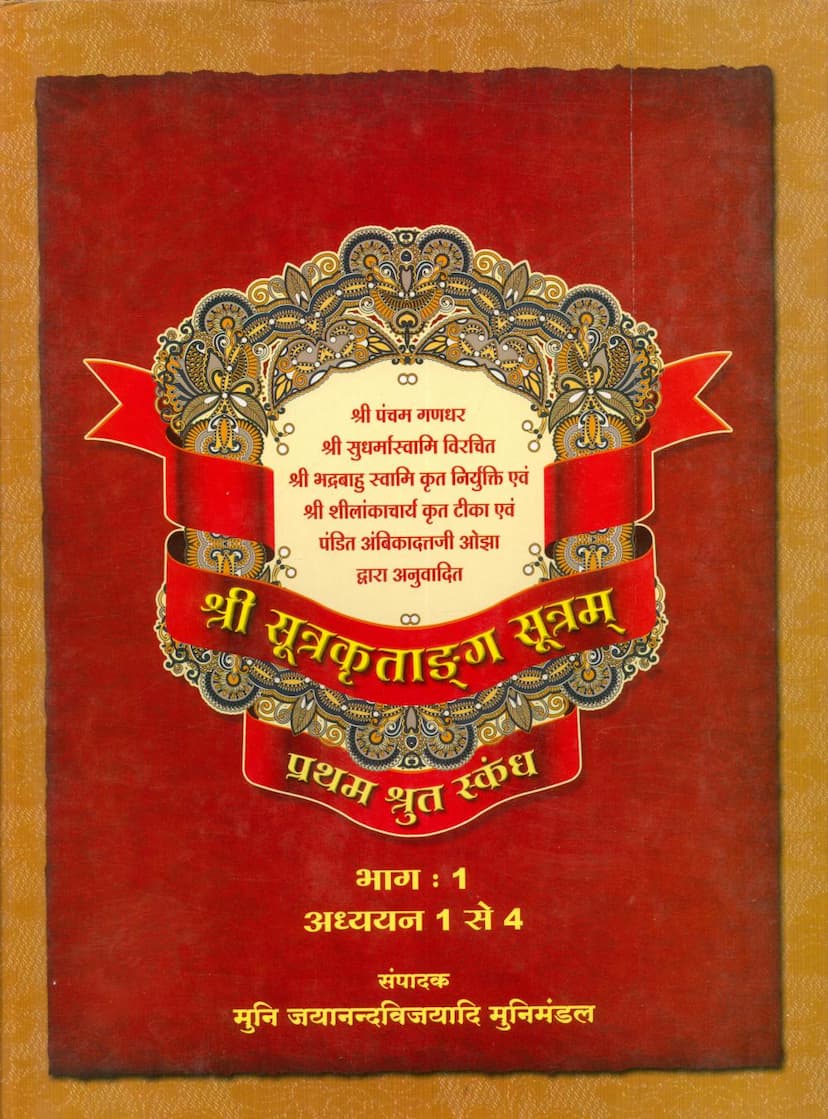Sutrakritanga Sutra Part 01
Added to library: September 2, 2025

Summary
The text you provided is a portion of the Sutrakritanga Sutra, specifically the first Skandha, Part 1, containing Chapters 1 to 4. This is a foundational text within Jainism, and the provided excerpt focuses on its introductory and contextual information. Here's a comprehensive summary based on the text:
1. Title and Authorship:
- Book Title: Sutrakritanga Sutra Part 01 (सूत्रकृताङ्ग सूत्रम् प्रथम श्रुत स्कन्ध : भाग : १)
- Author(s): Attributed to the Acharya Shri Jayanandvijayadi Munimandal (आ. श्री जयानंद विजयादि मुनिमंडल) for the compilation and editing. The original work is attributed to Shri Sudharma Swamiji (श्री सुधर्मास्वामि विरचित), the fifth Ganadhara of Lord Mahavir.
- Key Contributors: The text also highlights the work of Shri Bhadrabahu Swamiji (श्री भद्रबाहु स्वामि कृत नियुक्ति) for the Niryukti (commentary/explanation) and Shri Shilankacharya (श्री शीलांकाचार्य कृत टीका) for the Tikā (detailed commentary). Pandit Ambikadattji Ojha (पंडित अंबिकादत्तजी ओझा) is credited with the Hindi translation.
2. Meaning of "Sutrakrit" (सूत्रकृत्):
- The text explains the term "Sutrakrit" (सूतकृतम् सूतम्) as derived from two sources:
- "Sūta" (सूत): Originating from the Tirthankaras in the form of meaning (अर्थ रूपतया तीर्थकृदभ्यस्त).
- "Krita" (कृत): Composed by the Ganadharas in the form of sutras (सूत्र रूपेण गणधरैः कृतं).
- Therefore, "Sutrakrit" signifies something that originates in meaning from the Tirthankaras and is then established as sutras by the Ganadharas.
3. Publisher and Editorial Information:
- Publisher: Ramchandra Prakashan Samiti, Bhinmal (राज.) (श्री रामचन्द्र प्रकाशन समितिः भीनमालः (राज.)).
- Editors: Muni Jayanandvijayadi Munimandal (मुनिराज - श्री - जयानंद - विजयादि - मुनिमण्डलः).
- Special Mention: The text is presented with the guidance (तत्त्वावधान में) of Acharya Shri Jawahar Lalji M. (आ. श्री जवाहरलालजी म.).
- Supporting Trusts and Individuals: Pages 4 through 7 list numerous patrons and supporters, indicating significant community involvement in the publication. This includes various Jain trusts, families, and individuals from different cities like Mumbai, Delhi, Chennai, Vijaywada, Ahmedabad, and Rajasthan. These patrons have supported the publication through donations and sponsorships, often in memory of spiritual figures or for religious merit.
4. Introduction to the Sutrakritanga Sutra (सूत्रकृताङ्ग सूत्रम्):
- Importance: The Sutrakritanga holds a very high position among the Ahrat (Jain) Agamas. It describes subjects with great excellence, and a deep study of this text alone can lead to a successful life.
- Purpose: It is extremely useful for those seeking liberation (मुमुक्षु).
- Commentary: Understanding its profound meanings is not easy. To facilitate this, Shri Shilankacharya wrote an extensive and clear Sanskrit commentary (टीका). The importance of his commentary is known to Sanskrit scholars, but for the benefit of those who do not know Sanskrit, a Hindi translation of Shilankacharya's commentary was initiated.
- Features of the Translation: To aid readers, the translation includes the original Sanskrit text (संस्कृत छाया), grammatical analysis (व्याकरण), word-by-word meaning (अन्वयार्थ), and the overall essence (भावार्थ) along with the commentary's meaning (टीकार्थ). The editors acknowledge that while this extensive work increases the book's size, it greatly benefits those of ordinary intellect.
5. Structure and Content Overview (from Index Pages 9-11):
The index provides a glimpse into the structure and thematic coverage of the first Skandha of the Sutrakritanga, even though the detailed content summary is not present in the initial pages provided. The index mentions:
- Proposals/Introductions: General proposal for the Sutrakritanga, proposal for the first chapter, proposal for the third chapter.
- Chapters (Adhyayanas): The first Skandha has 16 Adhyayanas. The index lists Adhyayanas from the first to the fifteenth.
- Key Topics within Chapters:
- First Adhyayana: Sections on devotion to Shri Veer (श्रीवीरस्तुत्यधिकार), self-time exposition (स्व-समय वक्तव्यता अधिकार), exposition of other times (परसमय वक्तव्यता अधिकार), Charvaka doctrine (चार्वाकमताधिकार), Kutila definition (कुशीलपरिभाषाधिकार), Advaita of soul and body (आत्माद्वैतवादी अधिकार), Karma doctrine (तज्जीवतच्छरीरवादी का अधिकार), Akartavada (अकारकवाद का अधिकार).
- Second Adhyayana: Discussions related to the doctrine of the soul and body (तज्जीवतच्छरीरवादाकारकमतवादखंडनाधिकार), spiritual Dharma (भावधर्ममध्ययनं), Buddhism (बौद्धमत का अधिकार), refutation of former doctrines (पूर्वोक्तमतवादी अफलवादी है), Niyativada (नियतिवाद का अधिकार), Ajnanavada (अज्ञानवाद का अधिकार), Kriyavada (क्रियावाद का अधिकार), enjoyment of used items (आधाकर्म के उपभोगफल का अधिकार), world creator (जगत्कर्तृत्व का अधिकार), doctrine of action (कृतवादाधिकार), Shaivism etc. (शैवादि का अधिकार), renunciation of others (परतीर्थिक के परित्याग करने का कारण), renunciation of possessions (परिग्रहारम्भ त्याग अधिकार).
- Third Adhyayana: Mentioned as "Gaatha" (गाथा) or "Gaatha Shodashaka" (गाथाषोडशक).
- Fourth Adhyayana: Mentioned as "Stree Parigyna" (स्त्रीपरिज्ञाध्ययनम्).
In essence, this provided text is a foundational piece for understanding the Sutrakritanga Sutra, highlighting its spiritual and philosophical significance, its intricate commentary tradition, and the community's effort in making this knowledge accessible through translation. The introductory sections set the stage for a detailed philosophical discourse that the Sutrakritanga is known for, particularly its exploration of various philosophical schools and doctrines to establish Jain principles.